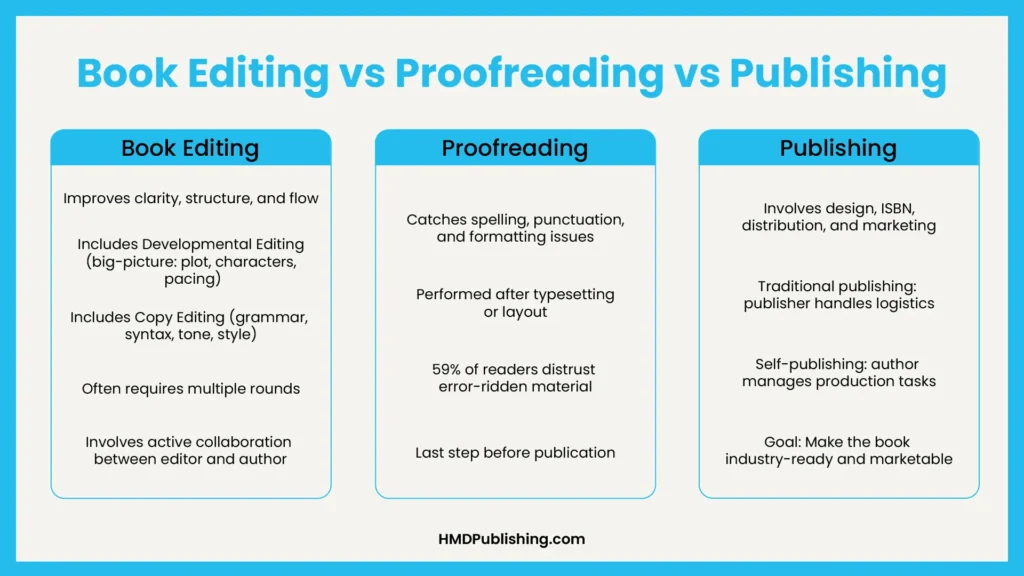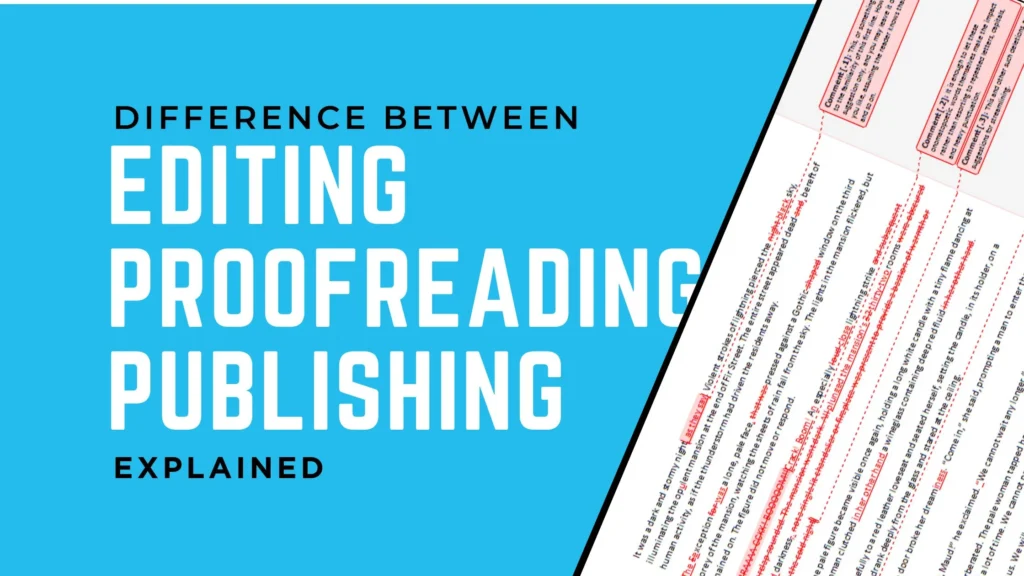The journey of publishing a book, from manuscript to publication, revolves around several critical stages, each with distinct purposes and a specialised professional approach. Authors often get confused in differentiating between editing, proofreading, and publishing, which can significantly impact the quality and success of their work.
This article serves as your guide to understanding the key differences, their roles, the professionals involved, and the reasons for confusion that persist. By understanding these differences, authors can navigate the publishing landscape effectively and ensure that their work receives the attention it deserves at each stage. Let’s dive into exploring.

Purpose of Each Step
How does editing improve a book’s content and structure?
Editing is not as simple as it may seem; rather, it is a multi-layered process focusing on improving a manuscript’s clarity, coherence, and quality. This process occurs early in the publishing workflow and often involves substantial changes to content, structure, and language.
The Ultimate Beginner’s Guide to Book Editing for 2025
Editing is a continuous process that often requires multiple rounds of feedback and revisions. For instance, a development editor may suggest revamping the chapters to enhance pacing and readability, while a copy editor might emphasize tightening the sentence structure to eliminate vagueness. Unlike proofreading, editing demands a collaboration between the author and editor, as some changes can alter the manuscript’s entire direction.
What does proofreading a book involve?
Proofreading, as its name suggests defensive is the last line process before publication against errors. It focuses on surface-level errors like spelling, punctuation, typos, and formatting, and any other inconsistencies, i-e, mismatched headers or page numbers.
This process occurs after the manuscript has been typed or formatted for print or digital distribution. The proofreaders ensure that earlier edits are free of errors and adhere to final design specifications. For example, they might catch a misplaced comma in a printed galley or a hyperlink in eBook scenarios.
While proofreading is less intruding as compared to editing yet its importance can not be overstated. Studies have shown that 59% of readers lose their trust in brand names due to error-ridden material, underscoring the financial and reputational risks of skipping the step one reading. However, proofreaders’ job is not to address structural or stylistic issues; rather, their role is purely corrective.
How do you go from writing a book to publishing it?
Publishing is the final process of transforming a polished manuscript into a ready-to-sell market product. It includes not only editing and proofreading but also design, production, distribution, and marketing. Publishers ensure coordination of the cover design, typesetting, and ISBN registration to ensure your book meets the required industry standards. They also plan strategies to launch campaigns, negotiate retail partnerships, and manage inventory for printing.
For example, in traditional publishing, houses that invest in authors whom they believe will succeed commercially often require agent representation. On the other hand, self-publishing moves these responsibilities toward the author, who is responsible for overseeing editing, design, and distribution on their own. However, publishing introduces creative and logical efforts to bring a book to its ideal audience.
Who Handles What in Each Phase
The Editorial Team
- Development Editors
These professionals are responsible for assessing the manuscript’s structure and offering suggestions about plot adjustments, characters, and thematic enhancements.
- Copy Editors
They specialize in language and style, refine sentence structure, correct grammar, and enforce consistency in spelling and terminology to ensure the manuscript aligns with genre conventions and the publisher’s requirements.
- Proofreaders
Proofreaders focus on technical accuracy and usually don’t interact more with authors. Rather, they offer the final defensive line before publication by scrutinizing the final text for errors.
The Publishing Team
- Acquisition Editors
These professionals are responsible for evaluating submissions, negotiating contracts, and acquiring manuscripts that align with the publisher’s requirements.
- Designers
They are responsible for designing cover art and interior layout to ensure the book is visually appealing, along with improved readability. They ensure stylistic consistency throughout the content.
- Production Managers
These professionals look into printing, eBook conversions, and quality control to ensure the process is meeting deadlines and budgets.
- Marketing Specialists
These are specialists responsible for enhancing book sales and visibility, from planning book tours to media coverage, they ensure the book’s presence.
Author’s Responsibilities
Authors are responsible for providing a manuscript that is complete before the editing process begins. They should collaborate with developmental and copy editors to review suggestions and implement changes. During publication, usually published authors focus on promotion, while self-published authors tend to manage design and distribution.
Best Self-Publishing Service Near Me
Why Authors Confuse These Terms
Overlapping Terminology
Authors are usually unable to see the blurred line between proofreading and editing. They consider it as something similar process that involves manuscript improvement, being unaware of the distinctions these processes have.
Misunderstanding Industry Practices
Publishers have specialized editors for each stage, while authors who choose to work independently can encounter freelancers who offer combined services without specific expertise. Authors may expect detailed structural feedback, while they may get only surface-level errors.
The Evolving Publishing Landscape
On one hand, where there is a rise in self-publishing platforms that give freedom to authors, there may be a lack of fixed rules and quality checks. Many authors may skip essential steps like proofreading or editing, either because they lack the speciality or think that these steps are not necessary.
Conclusion
Editing, proofreading, and publishing are different yet interconnected pillars of the book creation process. Editing helps in transforming a rough draft into a coherent narrative, proofreading ensures technical precision, and publishing bridges the gaps between the manuscript and the reader. Authors can make informed decisions by making themselves understanding the intricate key differences and their specific roles while avoiding costly oversights. Whether you are pursuing traditional publishing or self-publishing, investing in each step improves the book’s quality and its commercial potential.




